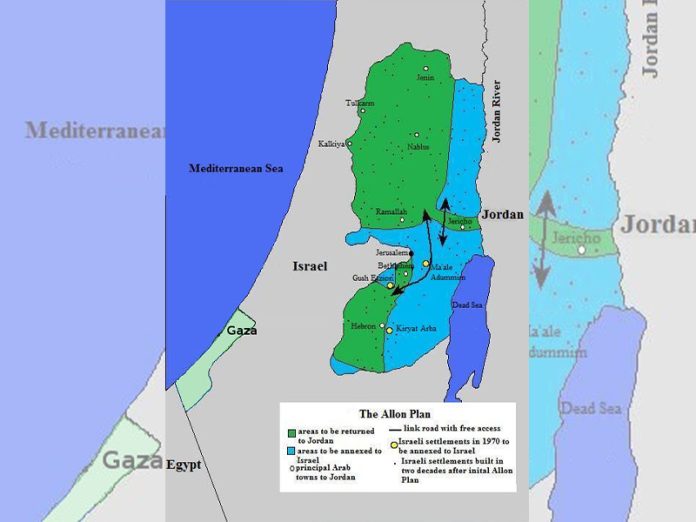
By Prof. Rasheen Bappu
The Allon Colonisation Plan: After decades of perfecting colonial control mechanisms for Palestinians inside the green line, Israel was more than equipped to impose an effective military governing system on the Palestinians in the West Bank and Gaza Strip. In 1966, Israel ended its martial law regulations for Palestinian villages inside the Green Line only to impose them once again in the West Bank and Gaza Strip after its victory in 1967.
The military occupation of the West Bank -including East Jerusalem- and the Gaza Strip persist to this day. This new status quo allowed Israel to pursue its goals of colonising the rest of the territory that made up mandatory Palestine. It is in this context that the Allon plan emerged. Named after its creator, Yigal Allon, this plan would see Israel permanently seizing control of vast territories of the West Bank through multiple methods, such as through military installations as well as settlements. The large Palestinian population centres would then either be given some form of nominal autonomy or have their control transferred to the Jordanian monarchy.
It was according to this plan that the colonial settlement enterprise in the West Bank and Gaza Strip was born. Settlements are colonies built on land under Israeli occupation outside the Green Line and are open only to Jewish Israelis. Initially, Israel constructed settlements in all the territories it seized in the 1967 war, including the Sinai and Golan Heights. For reasons that we will discuss in the next articles, the settlements in the Gaza Strip and Sinai were dismantled over time. However, in the West Bank and Golan Heights, this has only worsened. There were over 200 settlements and outposts dotting the entirety of these areas. These settlements were home to over 600,000 settlers, living on stolen and occupied territory. According to international law, these settlements were absolutely illegal, and their existence is a stark violation of the Geneva Conventions and other International norms.
If you were to look at the distribution of these settlements all across the West Bank, you would notice that there is a striking resemblance between their positions and the territory outlined in the Allon plan to be permanently seized by Israel. This is by design, and Israeli policy since the 60s has been to change the facts on the ground as much as possible to enable the theft of these lands. This colonisation drive persists to this very day through various annexations and land confiscations and did not even stop during times of peace negotiations. As a matter of fact, it accelerated during times of negotiations because the Israelis knew that the Palestinians would not want to jeopardise the negotiations, they desperately needed to establish a State. In addition to the settlements, the West Bank is dissected by military firing ranges, nature reserves and many other legalistic schemes to deny Palestinians access. This dissection is so severe, that the West Bank has jokingly come to be known as the West Bank archipelago, where small pockets of Palestinians are surrounded by Israeli-controlled zones.
The War of 1973 and Camp David: Despite the death of Nasser, Egypt remained determined to take back the territories it lost in the 1967 war. With the help of Syria, which had also lost its Golan Heights, they put together a plan to retake control of their occupied areas. This came in the form of the 1973 war, which was a game-changer in the region. In the first hours of the war, Egypt under the leadership of Anwar Sadat, was able to cross the Suez Canal and overwhelm the Bar Lev line, which was constructed by Israel to fend off any Egyptian attack. On the Northern front, the Syrians were able to advance well into the occupied Golan Heights. These early military victories were ultimately reversed as Israel strengthened its position with the aid of the United States. While the Arab forces repulsed, the war served as a warning sign to Israel that it could not forever guarantee that it would always be a victor in war.
This laid the groundwork for the 1978 Camp David Accords with Egypt, where the Sinai was returned to Egypt (with certain stipulations), in exchange for peace, normalisation and the Egyptian recognition of Israel. Furthermore, the fledgling Israeli colonies in the Sinai were dismantled. Egypt became the first Arab State to officially recognise Israel and began to reorient itself towards the United States and the West Bloc.
Among the various Clauses and Provisions of the Camp David Accords was the condition that the Rights of the Palestinian People were to be recognised and that some form of autonomy was granted to the Palestinians. While vague and noncommittal, this eventually paved the way for the secret negotiations between the PLO and Israel.
The Syrians, however, were not fair as well. The Syrian Golan Heights remained occupied to this day, and the State of war between Syria and Israel technically never ended. Israel used this as a pretext to illegally annex the Golan Heights, and colonise it in a manner similar to the West Bank and East Jerusalem.
This new status quo and the perceived shift in the balance of power ultimately culminated in the Palestinian Intifada and the Oslo Accords, which would for the first time allow the PLO leadership to return to Palestine in an endeavour to establish a Palestinian State. This will be discussed in depth in the next article.
To be continued, await Part IX
About the Author:
Prof. Rasheen Bappu, Anthropologist (Defence) and Intelligence Data Scientist, rasheen_bappu@aol.com
Post Disclaimer | Support Us
Support Us
The sailanmuslim.com web site entirely supported by individual donors and well wishers. If you regularly visit this site and wish to show your appreciation, or if you wish to see further development of sailanmuslim.com, please donate us
IMPORTANT : All content hosted on sailanmuslim.com is solely for non-commercial purposes and with the permission of original copyright holders. Any other use of the hosted content, such as for financial gain, requires express approval from the copyright owners.
 Sri lanka Muslims Web Portal Sri Lanka Muslims News Center
Sri lanka Muslims Web Portal Sri Lanka Muslims News Center
 Donate
Donate


